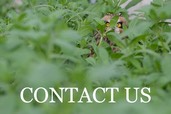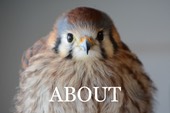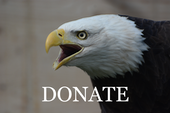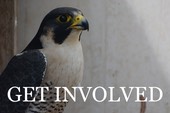Spring is in the Air… Even though it Looks Like Winter Outside

Red-tailed Hawk 19-026 was found near Baker City, barely able to fly. Volunteer Tara transported him to Pendleton. The young hawk, not quite one year old, had multiple puncture wounds on his chest and back. A likely scenario is he trespassed onto the territory of a pair of nesting hawks and was on the losing side of the battle that ensued. Fortunately, he seems to be recovering well.
Necessity is the Mother of Invention

American Kestrel 190-027 suffered a head injury when he collided with something, perhaps a window. In addition to his head injury, he appeared to have old fractures on the third digits (the longest toe) of both feet. The toe injuries did not affect his ability to catch prey, as he weighed 99 grams, a respectable weight for a wild, male kestrel.
We decided to try and straighten the crooked toe since it sometimes got tangled with the fourth digit. We split a small piece of IV tubing lengthwise and slid it around the toe, using vet wrap to hold the splint in place. There is a small piece of tubing in the photo above, near the bandaged toe. It took a couple of days for him to decide he could eat whole food, bur he’s eating two mice/day.
Golden Eagle 18-765 Update
The eagle’s vision is still limited, but his coordination is improving. We are feeding him whole quail, and he’s getting better and better at being able to hold the quail with his feet, and tear them into bite-sized pieces. During the past two weeks he has started dropping wing feathers. Losing feathers 4 to 6 weeks after a wing injury is a fairly common occurrence, but as of Saturday (when the photo was taken), he had dropped 28 feathers. He lost 11 more on Sunday! How he could receive so much blunt trauma, and not have any broken bones or massive internal injuries, is amazing.
We generally assume when a bird is admitted with a collision injury, there have been two collisions. The first occurs in the air, with a vehicle, power line, window, etc. The second occurs when the bird hits the ground. The eagle was struck initially on the right side. The majority of the feathers below are from the right wing, although most of the feathers on the bottom of the cage Sunday morning were from the left wing. One thing is for certain, he has to grow a lot of feathers before there is any possibility of flight.

Red-tailed Hawk 19-029... It takes a Village
A snow plow driver found this adult female hawk near Yakima. She is a classic example of the dedication and cooperation demonstrated by BMW volunteers and partners. Volunteer Mark picked up the hawk from WDFW in Yakima and transported her to the Pet Health Clinic in Sunnyside, where veterinary technician and BMW volunteer Vanessa provided first aid. Vanessa transported the hawk to the Tri-Cities Center on her way to Benton City, where she lives. Michele and Laurel provided supportive care for the hawk there, until Pam could transport her to Umatilla, where she met Bob who brought the bird on to Pendleton.
The intake exam revealed a fracture in her lower right jaw, fractures and a puncture wound in the roof of her mouth, bruising in her left eye and a lead level of 16.3 micrograms/deciliter, a toxic amount of lead. We started supportive care and then scheduled an appointment with Dr. Yackley at Pendleton Veterinary Clinic. After an exam, Dr. Yackley concluded the prognosis for a complete recovery was good.

To minimize movement of the hawk’s lower jaw, we are administering fluids intravenously via a catheter in her jugular vein, rather than giving them orally. It requires briefly anesthetizing her, but she recovers within minutes and is soon ready to take on the world!








